I often get the question “what do you do with the bees in winter?”. People assume that I have a half-year vacation every year – you don’t see bees when it’s cold, right? But actually, winter is a crucial phase of the bee year. Honey bees aren’t as inactive as it may seem from the outside. They – usually – don’t produce honey over the winter, that’s true. But there’s quite a bit of activity in the hive also when it’s freezing outside. And this definitely relates to bee health. So, let’s go step by step.
What do honey bees do in winter?
Honey bees like it warm, so the winter isn’t the ideal period for them. When temperatures are below 12°C, they don’t fly out. They stay in the hive and form a so-called winter cluster. While the colony is distributed all over the different combs in summer, in winter they “snuggle up” forming a ball. By this, they lose not as much heat. The queen stays in the centre of the cluster – well-protected and warm.
After a few days of frost, the colony stops breeding. In the winter time, there aren’t enough flowers to feed the brood. The adults (workers and the queen) feed on the stores they have formed over the summer. So, the honey they made wasn’t meant for us – it’s their food for winter. This is why it’s so crucially important to feed them in late summer!

Bee health in winter
In the centre of the winter cluster it’s about 35°C warm. This needs a lot of energy. Therefore, they need sugar as “heating material”. This is why honey bees make large honey stores during the summer. If beekeepers harvest it, they have to replace it with other feed – usually sugar syrup. Not to starve is the
Unfortunately, starving is a very common reason for winter losses. In most cases, it’s the beekeepers fault who didn’t feed enough. As a rule of thumb: the longer and colder the winter is in your region, the more you have to feed. With a cooler temperate climate like here in Germany, this means about 20 kg of stores for a full colony. Stores, not syrup! In colder regions (Skandinavia, Canada…) it’s more, in warmer areas much less.

Varroa and bees in winter
Starving, however, comes only at the second position of the reasons why honey bee colonies die over winter. The first: Varroa. You may have guessed it. Their survival depends on the treatment you did in summer. Only with a proper treatment, the winter bees grow up healthy.
In winter, however, you have to treat again. Now it’s for making sure that your colonies start with as few mites as possible into the next season. Varroa treatments are always both curative (getting rid of mites now) and preventive (taking care of the future). For the winter treatment, I recommend oxalic acid. The best substance we have for that, in my opinion.
Winter – bottleneck for survival
Varroa and starving – these are the most frequent reasons for winter colony losses. Winter, however, it’s the bottleneck for the survival of the honey bee colony. Winter losses up to 15% are normal. Which doesn’t mean that you shouldn’t try to keep them even lower! If you take good care of the two points above, you have a good chance to keep healthy bee colonies over winter.
Being such an important period for honey bee colonies and their health, I’m also busy in winter. For instance, I do clinical studies for varroa treatment in winter. Not every substance we have for the treatments is good both in summer and winter. So, this has to be tested before a product gets on the market.

Studies for bee health in winter
Varroa treatments are not the only bee health products I test in winter. For instance, there are some feed additives that are added to the winter feed. If the producers do any health claims about their product, they have to demonstrate these are right with data.
Health claims may be “your bees start stronger into the season!” or “better overwintering success!”. If there are not data, no studies, no tests behind it, then it’s just words. And often not true.
These tests are also important to make sure that nothing of the product remains in the human food in the end. In our case, in the next year’s honey. Also in this case you do a study over winter and take the samples of the first honey. Though, this is more for consumer, i.e. human, health than bee health.
Effects of pesticides on bees in winter
Finally, pesticides are a usual suspect when it comes to higher winter colony losses. “Sublethal effects” are those that don’t kill the colonies immediately, but on the long term. In some higher tier studies for registration, we’ve moved the colonies to a separate overwintering site after the exposure time to the pesticides. The colonies are then checked in spring to compare their survival and development to unexposed colonies.
Actually, this aspect was included also in the reviewed Bee Guidance from EFSA. They now require a separate risk assessment for the winter period. This means that it’s necessary to assess a “summer bee scenario” and a “winter bee scenario”. This also shows that this review definitely wasn’t to undermine the rigid rules of the guidance. All the contrary, there are a few new points that will keep me working over winter.
Want to learn more about bees in winter?
Bees in winter and much more on what influences their health is part of the Bee Health Course that will start again end of January. Sign up to the Bee Health Letters to get more details. Just scroll down to “Keep current with BeeSafe!” and fill out the form. You’ll get all the info when the doors open to sign up!



As a vet and beekeeper I realy loved reading your article! Even some sentences are almost the same I use to repeat constantly.
From August the local beekeepers only talked about velutina. Any discussions about varroa or feeding…
Congratulations!
Thank you! Yes, it’s a neverending discussion. But slowly we’re progressing!